The Cake and the Marble
----------------------------------
Medium: Mixed Media: 3D modeling, drawing, print, writing
As a child I stared into a glass marble, fascinated by the refracted light and shifting shapes within – a small universe that reflected the outside world in a strange, unrecognizable way. Those distorted reflections felt like a secret space, just beyond my reach. Now that world lies in pieces. Each fragment resembles an unevenly sliced cake: layers of biscuit, cream, fruit and jam. The top layer? A series of miniature scenes, key moments from fifty years of family portraits.
This project is a cartography of memory within a framework of national, cultural, political and social identity. In The Cake and the Marble I investigate how personal history relates to broader cultural and historical structures. Where my earlier films and digital works focused on large-scale systems – financial markets, media logics, speculative futures – here I reduce the scale to a microhistory. By cartographing fragments of my family archive, I attempt to make visible the interplay between individual experience and collective memory.
Within this project, cartography functions not only as a visual tool, but also as a conceptual model. I work with the tension between two cartographic approaches: intensive and extensive projection, and use both as methods.
----------------------------------Intensive cartography focuses on the internal relationships within a system — density, distribution, intensity. This is in line with how memory works: layered, non-linear, fluctuating. Some experiences swell, others remain fragmentary. Memory functions as a sedimentary structure, where everything is present at once, without clear hierarchy.
A specific modality within this framework is orthographic projection. In contrast to perspectival projection, orthographic representation preserves parallel lines, without distortion by distance: objects near and far are the same size, spatial depth flattens. In my animations, I use this lens to build up scenes as layers of time — not linearly, but in a compact layering. The miniature scenes are all given the same scale and attention, regardless of their place in time.
Extensive cartography, on the other hand, is based on scale, distance and coordinates. It arranges experiences within a shared grid: timelines, geographical places, perspectives. It is a way of situating — and therefore also of communicating. In my work, this means: providing the particular with coordinates. By adding details — a date, a piece of clothing, a place, a posture — I give the other person handles to relate to my experience. It makes the inner transferable, without reducing it.
----------------------------------Extensive cartography touches on translating something personal into something that becomes shareable. Where intensive cartography is about inner intensity and layers of experience, extensive cartography focuses on situating experiences in a shared field of reference points, which makes communication possible.
In other words: extensive cartography offers the possibility of letting the other person look along, by placing the experience in a kind of measurable or traceable grid — without having to take away the intensity. This is an important way in which my way of working functions: I create a personal logic of images, which I then provide with coordinates that others can enter.
In this way, my work constantly moves between both models. Between the intensive logic of memory — fluid, fragmentary — and the extensive structure that is necessary to share experiences. The personal is projected into a field where the political and historical can play a role.
----------------------------------An example:
The woman is wearing a light blue dress with a checked pattern, a row of buttons down the front and a firm pleat in the skirt. Her hair is short and blond, she is wearing sunglasses and is holding an ice cream. Her posture looks a bit uncomfortable, her feet point inwards. The dress has something timeless. The moment — a summer, a journey — remains detached from concrete time or place. In an intensive reading, it is not the distance in years or kilometers that counts, but the intensity of the memory.
The fabric of her dress — which also became my blouse — is more than textile. It is a grid in which memory can nestle. A structure that invites projection. By treating the family archive — slides, photographs, anecdotes — as a terrain of shifting projections, a cartography emerges that reveals the stratification of memory and representation. Something Utterly Original is an ongoing negotiation between private and public, between past and present, between intensity and location.
In The Cake and the Marble I started working with old, found photographs of my parents and grandparents — images taken at very different moments: as a child, as a young adult, later as an older person. They come from different times, contexts, perspectives. I use these images with a technique that was originally intended to reconstruct faces three-dimensionally by entering photographs taken within one situation, within one moment. In my case, it is therefore not an exact, technical application, but rather a reflective investigation. I do this not to produce a closed image of identity, but to investigate how all those layers, moments and looks relate to each other. The act accompanies my reflection on origins and memory. Not as a measuring instrument, but as a way to literally form an image of how memory nestles in faces, postures, textures. The images collide, slide over each other, leave gaps. The result is not a closed portrait, but a fragmented surface. For me it means a more intense way of looking.
----------------------------------


